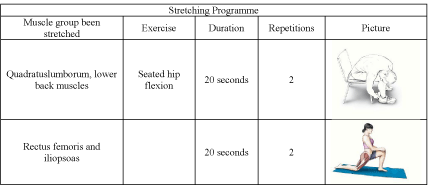
Short Communication
J Dent App. 2015;2(3): 188-189.
Practical Advise Pertaining to Lower Back Pain among Dentists
Terry J Ellapen1*, Johan H Van Heerden1 and Yvonne Paul2
1University of Kwa Zulu Natal
2Tshwane University of Technology
*Corresponding author: Terry Ellapen,University of Kwa Zulu Natal
Received: December 15, 2014; Accepted: February 04, 2015; Published: February 06 , 2015
Incidence of Lower Back Pain among Dentists
Work related lower back pain (LBP) is a common malady of dentistry [1]. The aetiology of dental LBP has been associated with poor work practise precipitating deviant intrinsic lumbopelvic musculoskeletal alignment [2,3]. Poor dental work practise includes habitual standing in unnatural positions for prolonged periods during dental consultations, which anteriorly tilts the practitioner’s lumbopelvic complex known as short arc pelvic on femur flexion [3,4]. When this occurs, the sagittal plane force couple relationship of the lumbopelvic musculature is abnormally altered [4]. The iliopsoas, rectus femoris and satorius muscles become concentrically shortened which pulls the pelvis forward, while eccentrically lengthening its antagonists (gluteal, hamstrings and rectus abdominis) [4,5]. Prolonged habitual bending at the hip during dental consultations produces iliopsoas contractures [3,6].
Another scenario that precipitates deviant intrinsic lumbopelvic musculoskeletal alignment is the dentist’s somatotype.There are two predominant somatotypes, the android and gynoid. Android fat distribution is mainly around the abdominal region, commonly known as apple-shaped obesity [7]. Gynoid fat distribution occurs predominantly around the hips, buttocks and thighs commonly referred to as pear-shaped obesity [7]. Physical inactivity and unhealthy eating patterns precipitate either somatotype, which produces excessive accumulation of adipose tissue around the individual’s lumbopelvic complex, thereby facilitating anteriorly tilted pelvis [8,9]. Dental research is primarily focused on improved health care service to the patient and highlighting innovative dental technology but limited thought is given to the health and functional status of the dentists. Often young dentists, dental students, physical therapists, biokineticists, physical therapy and biokinetic students enquire about an appropriate solution to the above-mention malady. This short communication provides ergonomic and core stability recommendations.
Practical Advice to Diminish Lower Back Pain
Dentists must adopt better ergonomic practises and regularly perform core stabilization exercises [6,10].The ergonomic practises will include:
- Increase patient’s seat height thereby eliminating the need to excessive flex/bend one’s lumbopelvis.
- Dentists should resume an erect standing posture after every 30 minutes of continuous prolonged lumbopelvic flexion.
- Female dentists must refrain from wearing high heel shoes when consulting, because it increases their anterior pelvic tilt (Figure 1 and 2).
- All stretching should be performed statically for a minimum of 20 second per stretch and/or muscle group, two repetitions [5,9].
- Muscles that must be stretched include iliopsoas, rectus femoris, satorius, lumbar erector spinae and quadratus lumborum [5,9].
- Muscles that must be strengthened include gluteus minimus, medius and maximus, hamstrings group and abdominal group (rectus abdominis, external and internal obliques and transverse abdominis) [5,9].
- Abduljabbar TA. Musculoskeletal disorders among dentists in Saudi Arabia. Pakistan Oral and Dental Journal 2008; 28: 134-44.
- Leggat PA, Kedjarune U, Smith DR. Occupational health problems in modern dentistry: a review. Ind Health 2007; 45: 611-621.
- Yamalik N. Musculoskeletal disorders and dental practice Part A. Risk factors for dentistry, magnitude of the problem, prevention and dental ergonomics. International Dental Journal 2007; 57:45-54.
- Mansfield PJ, Neumann DA. Essentials of Kinesiology for the Physical Therapist Assistant (1sted.). MOSBY Elsevier 2014.
- Prentice WE. Rehabilitation techniques for Sports Medicine and Athletic Training. Champaign, IL: Human Kinetics, 2011.
- Valachi B, Valachi K. Mechanisms leading to musculoskeletal disorders in dentistry. Journal of American Dental Association 2003; 134: 1344-1350.
- Kent M. Oxford Dictionary of Sports Science and Medicine. Champaign: IL: Human Kinetics 2005.
- McArdle WD, Katch FI, Katch VL.Exercise Physiology: Energy, Nutrition and Human Performance (6thed.). Baltimore: Maryland: Lippincott Williams and Wilkins 2010.
- Houglum PA. Therapeutic Exercise for Musculoskeletal Injuries (3rded.) Champaign: IL: Human Kinetics 2007.
- Ellapen TJ, Narsigan S, Van Heerden HJ, Pillay K, Rugbeer N. Impact poor dental ergonomical practice. SADJ 2011; 66: 272-277.
- Nelson AG, Kokkonen J. Stretching Anatomy. Champaign: IL: Human Kinetics 2007.
- Delavier F. Strength Training Anatomy. Champaign: IL: Human Kinetics 2001.

Figure 1: Adapted from Nelson & Kokkonen, 2007 [11].
A core stabilization programme.

Figure 2: Adapted from Delavier, 2001) [12].
Core stabilization advice includes strengthening and stretching exercises. Physical therapy and biokinetic research has demonstrated the effectiveness of core stabilization in alleviating LBP [5,9]. Please note dentists should seek medical consent from a medical practitioner, physical therapist and/or a biokineticist before engaging in these recommended exercises.The stretching exercises should include the following;
References